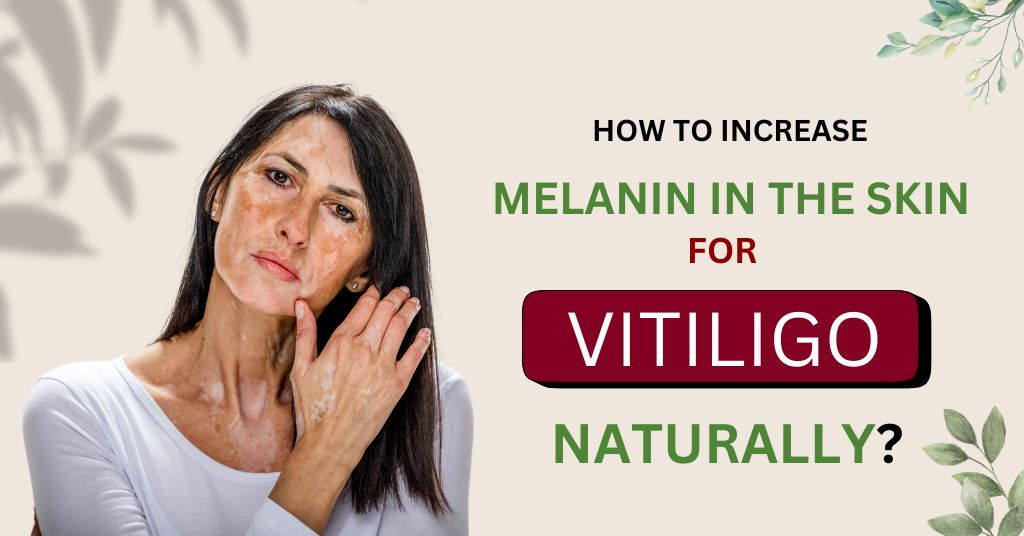Can certain foods aid in the formation of melanin in vitiligo?
Vitiligo is a condition that leads to the development of white patches on skin. It is classified as an autoimmune disorder, where the body’s immune system mistakenly attacks melanocyte cells. These cells are accountable for the production of melanin, the pigment that gives skin its colour.
Doctors suggest that consuming foods rich in vitamins A, C, and E and antioxidants can boost the production of melanin naturally. In this article, we have mentioned the list of such foods divided according to their nutrient benefits. However, certain food items can adversely affect the condition, and vitiligo patients must avoid them. In the end, you can also find a list of vitiligo foods to avoid. Continue reading to know more.
Foods to increase melanin production naturally
Here, we mention the most beneficial food items that might benefit vitiligo patients. However, it is important to note that these diet changes won’t give you overnight results, and you must stick to them for a few months to see a difference in your skin condition with white patches.
Antioxidants
The primary role of antioxidants is to harmonise the free radicals present in our body. Free radicals are generated through regular cellular activities, as well as from sun exposure, smoking, certain illnesses, diet, and other such causes. They can influence the functioning of other cells in the body and may play a role in the ageing process.
Antioxidants function by absorbing free radicals, preventing them from harming healthy cells. Micronutrients such as flavonoids and polyphenols, which are derived from the plants we consume, serve as potent antioxidants and may influence melanin production. Such food items include;
- Leafy greens such as spinach
- Nuts and seeds
- Whole grains like whole wheat, millet, and brown rice
- Dark chocolate
- Beans
- Berries
Vitamin A-rich foods
The essential active forms of vitamin A are retinal and retinoic acid. Retinal is needed for the process that starts melanogenesis, which is the production of melanin. Retinoic acid helps control hair follicle stem cells, healing wounds, and melanocyte stem cells, which are involved in skin colour. Vitamin A-rich foods include;
- Carrots
- Tomatoes
- Avocado
- sweet potatoes
- Fish
Vitamin E-rich foods
Along with defending your skin from sun damage naturally, vitamin E also help accelerate the production of melanocytes. Increasing the consumption of vitamin E-rich foods can also help maintain optimum skin hydration. There are certain studies that also suggest the efficacy of vitamin E in managing the oxidative stress of our cells. The list of food items to be a part of your vitiligo diet plan includes;
- Spinach
- Avocados
- Almonds
- Olive oil
- Sunflower seeds
Zinc
Zinc is a small but essential element that aids in the production of melanin. It is necessary for melanin synthesis and works in conjunction with copper. Zinc alpha-2-glycoprotein (ZAG) is a protein found in the bloodstream that regulates melanin production in healthy cells. When ZAG is produced in excess, it can inhibit melanin production.
Zinc may help treat vitiligo by preventing the accumulation of harmful substances and reducing the risk of infections. A deficiency in zinc can compromise the immune system, potentially exacerbating vitiligo symptoms. Foods that contain zinc include;
- Chickpeas
- Lentils
- Kidney beans
- Pomegranate
- Soybeans
- Sweetcorn
Copper
Copper is an essential component of the enzyme tyrosinase, which is necessary for the synthesis of melanin. Tyrosinase facilitates the conversion of the amino acid tyrosine into melanin. When there is insufficient copper, the activity of the enzyme is diminished, potentially resulting in reduced melanin production and causing tiny white spots on skin or grey or white hair. Copper-rich foods include;
- Peanuts
- Cashew nuts
- Lentils
- Walnuts
- Sunflower seeds
Vitamin B12 and Folic Acid
Vitamin B12 and folic acid can support melanin production by working together to reduce homocysteine levels. High homocysteine can lower the activity of tyrosinase, an enzyme needed for melanin production.
- Chickpeas
- Kidney beans
- Peas
- Broccoli
- Brussels sprouts
- Bananas
- Wholegrain
Foods to Avoid in Vitiligo
As some foods can boost the production of melanin, certain food items can also inhibit its production. Here is a list of vitiligo-avoid foods;
- Processed foods
- Junk food
- Red meat
- Citrus fruits
- Soda
- Sugary foods
- Dairy Products
- Nightshade Vegetables
- Alcohol
- Smoke
- Caffeine
- Pickles
Other helpful tips for vitiligo patients
It is important to implement certain lifestyle changes for vitiligo patients. These changes can help them prevent the further progression of vitiligo and maintain their skin health.
- Clothing: While going out, especially during peak sun hours, be sure to cover yourself properly. You can use a hat or scarf to cover your face.
- Stay Hydrated: Drink enough water throughout the day. This will help in maintaining skin hydration.
- Stress Management: Maintain a calm and peaceful mood. To achieve so you can practice meditation or participate in hobbies
- Tattoos: Don’t get tattoos, as they consist of harmful chemicals that may be harmful to you. Also, do not go for tanning beds, as they may damage your skin.
- Look after your immune health: Take care of any autoimmune condition by getting treatment and following your doctor’s advice.
Homeopathy for Autoimmune disease
Homeopathy is one of the most viable treatment options for achieving relief from various autoimmune disorders. It aims to address the causative factors behind the occurrence of conditions such as vitiligo on lips, psoriasis, acne, etc. and treat the disease from its roots. The treatment plans achieve this by correcting the underlying imbalances present in the immune system.
Homeopathy has been proven to be the best medical system for increasing melanin production and restoring normal skin pigmentation, even in vitiligo. Homeopathic treatment for white spots on skin involves tailoring the medicine to the individual symptoms and characteristics of each patient. The selection of a homeopathic remedy for vitiligo is based on the patient’s physical, emotional, and mental symptoms, as well as their unique constitution. This approach recognises that each person with vitiligo has a distinct experience, and it emphasises the importance of personalising the treatment to meet each individual’s needs.
Bharat Homeopathy; – Treat vitiligo naturally
At Bharat Homeopathy, we provide the best care possible to each and every vitiligo patient. Our doctors have years of experience in treating such conditions. They implement a holistic approach by analysing a patient and prescribing customised side-effect-free homeopathic medicine for vitiligo catered to the needs of the patient. The treatment is also effective in preventing the chances of recurrence of the condition. To receive the best treatment for contact us today.


